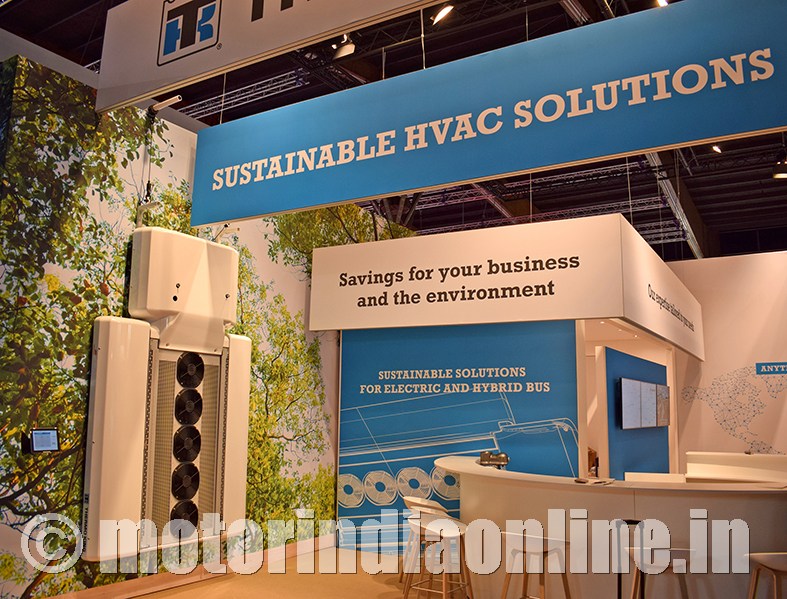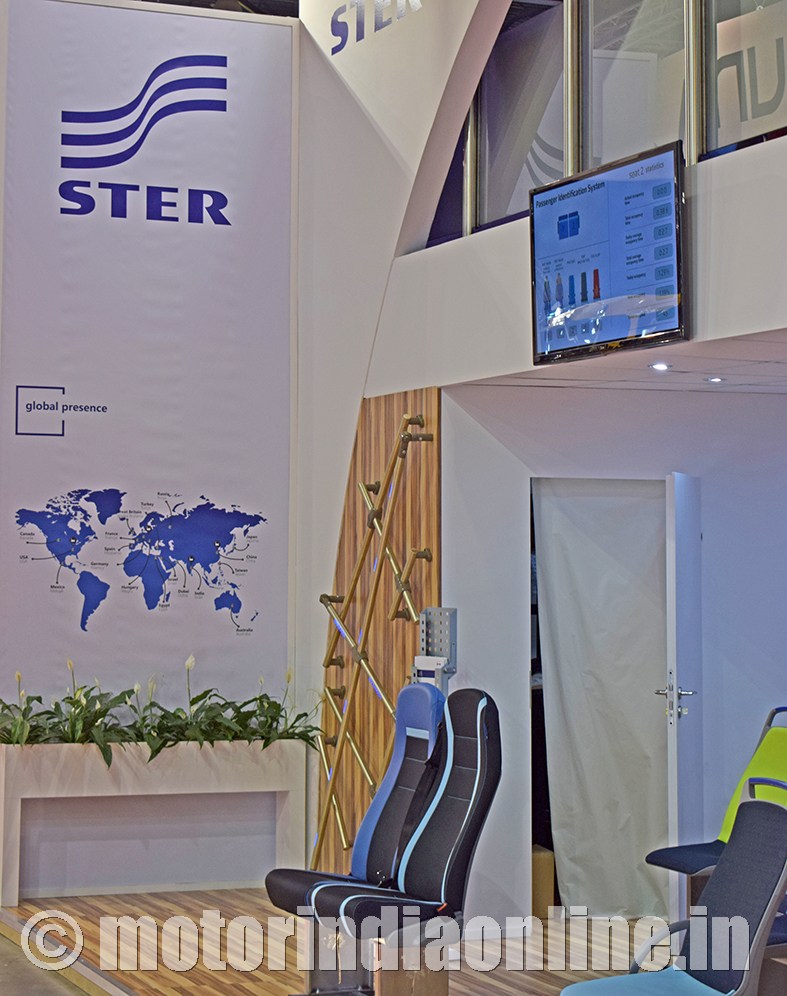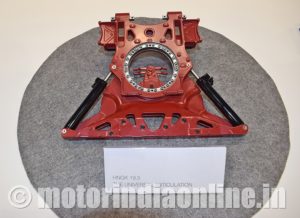Anybody who had visited Busworld Europe 2017 will tell you that it is an ocean of products and technology that makes the transport industry what it is today. The over-packed two days of press conferences conducted by OEMs (bus and coach builders) witnessed several new launches. There were also hundreds of component and aggregate suppliers that made the show a grand one for over five days. In this report, we put the well-deserved spotlight on the work done by the suppliers who innovate and pave way for the future of transportation.
Thermo King’s unique heat & electric water pump
Thermo King presented its sustainable heating, ventilation and air-conditioning solutions with a focus on hybrid and electric buses. “Heat pumps have proven to be the technology that reduces the power consumption of electric buses, thus ensuring a wider reach with still a guaranteed comfortable climate for passengers. We have a heat pump unit which we introduced 2½ years ago, and sold more than 400 of those now available in the market. Today we have the most efficient heat pump in the market for the biggest fleets in Europe. We have improved on heat regeneration with an integrated battery cooling, use that heat to heat the vehicle. We have electronic coolers inside to make the unit more efficient,” informed Ronald Aan, Area Sales Manager – Bus HVAC, Thermo King.
Clearly, Thermo King wants to respond to the increasing importance of sustainable transport in Europe. Its electric water pump series Athenia has already been providing comfortable cooling and heating in hundreds of electric buses in Europe.
Many European municipalities and cities see more sustainable passenger transport as a solution. Elaborated Aan: “We see an exponential growth in the application of the electric buses given the sales are doubling and in some cases tripling every year. Our further improvements will be in the areas that we can operate the unit in minimum temperatures. At this moment we are at -7 degrees. The next generation will be for -15 degrees where we will be able to heat the bus.”
Telma’s Axial & Focal retarders
Telma showcased its range of electro-magnetic retarders for commercial vehicles starting from mini buses to heavy trucks covering the whole range of vehicle types and torque. Amongst the two main product lines, one is called Axial because it is installed in the drive-line between the gearbox and the driven axle, mostly in the front engine vehicles. It is usually used when the drive line is long. The second is called the Focal range, designed specifically for the rear-engine coaches and short wheelbase tractor units.
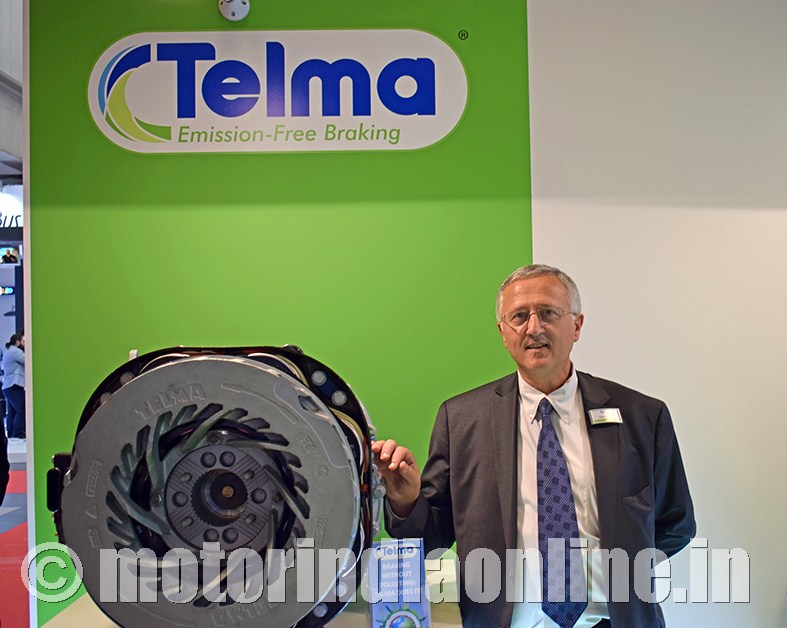
This Telma Focal series of retarder is mounted directly to the gearbox or axle. All the variants and adaptations of Telma Focal have been thoroughly released with associated transmission manufacturer validation.
India is also a key market for Telma and they have been working with a couple of key OEMs in India. Said Marc Gross, Technical Application Manager, Telma: “We do not produce in India, we mostly send it from France. However, we have a manufacturing plant in China. So we also utilize that plant for India and the rest of Asia. We have relationships with most of the manufacturers and OEMs, and they also know Telma for its robustness, reliability, safety, cost-effective, environmental protecting benefits.”
Vision Zero, the central theme at ZF pavillion
The message from ZF in the Busworld 2017 was vision Zero. It meant Zero accident as well as Zero emission. Zero accident was signalling towards autonomous driving and zero emission meant electric. Thierry Dupin, Manager, Commercial Vehicle Technology, Technical Service MT & AMT, Customer Service & Quality, ZF Friedrichshafen AG, said: “In order to realize Vision Zero – a future of mobility with zero accidents and zero emissions – ZF continues to expand its portfolio of innovative technologies in the areas of driveline, chassis and safety technology.”
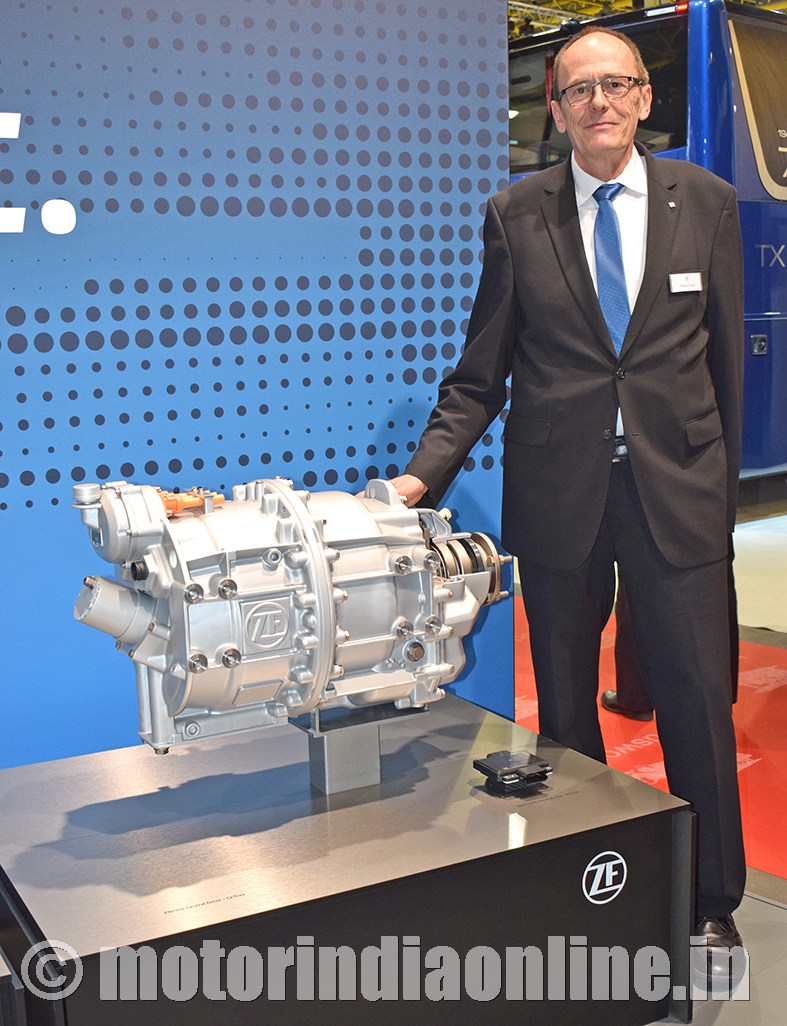
As a leading supplier of automotive technology, ZF is also able to network steering, camera, sensor and control units. Intelligent mechanical systems allow ZF in contributing towards Vision Zero in the commercial vehicle sector. Electric and hybrid drive solutions for a variety of busses and coaches are a few fine examples of the company’s potential. ZF is also continually improving on its mechanical components, making them lighter, more fuel-efficient, powerful and durable. In addition to its in-house development work, the company has also set up a Vision Zero Ecosystem, a growing network of highly specialized partners.
Added Dupin: “One of the products at the pavilion the CeTrax central drive packs a maximum output of 300 kW and a maximum torque of 4,400 Nm. The bus accelerates from standing without any torque interruption, so passengers don’t notice a thing. Comfort is also ensured by much lower chassis vibrations plus a quieter ride compared to conventional engines. Another product is the ZF-EcoLife 6-speed automatic transmission that enables stop/start function with the engine that can be switched off, contributing to fuel savings.”
ZF-EcoLife is the worldwide benchmark for automatic bus transmissions used in the most demanding application area – the city traffic. Based on this, the technology company is expanding the transmission family with the ZF-EcoLife Coach version. This is specifically designed for use in inter-city buses and coaches and for particularly demanding routes. The torque converter in the ZF-EcoLife Coach transmits input torques of up to 2,300 Nm, and thus the comparably high performance of coach engines.
Ster keeps growing
Alongside its growing range of lightweight seats, Ster showcased its intention to be able to make everything that goes with the seats. “Our superior product features and advanced seating technology has made us what we are today. We are well known and accepted for safety, quality, design and durability. In addition to light-weight seats, we are showing some examples of seat peripherals. Seating is just one product that is amongst the various elements that goes with it for interiors. We are capable of doing whatever you see in the bus around the seats,” informed Mr. Piotr Nowak, Marketing Director, Ster Sp. Zo.o.
The company also showcased the antibacterial+ seat with silver nanoparticles that combat bacteria. Apart from this the company prides in its easy-to-handle and manageable seats “Our seats are profile which is just two pipes and the seats are pushed inside and screwed just like assembling a furniture. Hence it is light weight and even a bus operator can fix it in case of any problem. The bus need not stop for weeks. As of today, we can make close to 4,000 buses a year, said Mr. N. Vaideshwaran, Country Manager, Ster India Pvt. Ltd.
Valeo’s intelligent climate control solutions
At the Valeo pavilion the spotlight was on the full range of Valeo technologies that keep the cabin interior at an optimal temperature at any latitude, regardless of the weather, the size of the vehicle, its powertrain type, and the nature and duration of its journey (whether urban, peri-urban or long-haul). As the world leader in CO2 emissions reduction, Valeo proposed lineup of innovative heating, ventilation and air-conditioning (HVAC) solutions specifically designed for electric and hybrid buses and coaches.
Valeo’s REVO-E Global, family of electric roof units plays a leading role in electric- and hybrid-bus HVAC systems. Its modular design makes them adaptable to the full spectrum of customer needs, especially in Asian markets. Special emphasis has been placed on keeping the weight of the structure light, extending the output range and simplifying installation. REVO-E Global has already proved its worth in many countries around the world. The system comes with a heat-pump option and/or heating components, making it possible to boost the vehicle’s range while effectively and efficiently maintaining the cabin temperature at a comfortable level, even in very cold weather.
Thanks to the fully automatic defrosting feature, the heat pump works even when the outside temperature falls quickly. The REVO-E Global electric roof unit is affordable to run. With its hermetically sealed refrigeration circuit, REVO-E Global requires virtually zero maintenance and is leak proof. Its low overall weight, energy efficiency and constantly regulated heating function ensure that the vehicle’s range is maximized.
Entertainment & security systems by CARBON
Based out of India and owned by Hi-Tech Computers, Carbon showcased next-generation entertainment and security systems for buses. “We are looking at the niche entertainment segment which is Video on Demand that can provide content (movie, songs,) maps, e-books, games along with opening up a source for the bus operators to gain revenues in terms of advertising. The bus operator can also have customized advertising depending on the types of passenger they are boarding. They can also do BYOD-Bring your own device and passenger can use his / her mobile, while the device gets connected to our server set-up on the bus. Each server can support 60-70 passenger,” informed Kumar H, Marketing Director, CARBON.
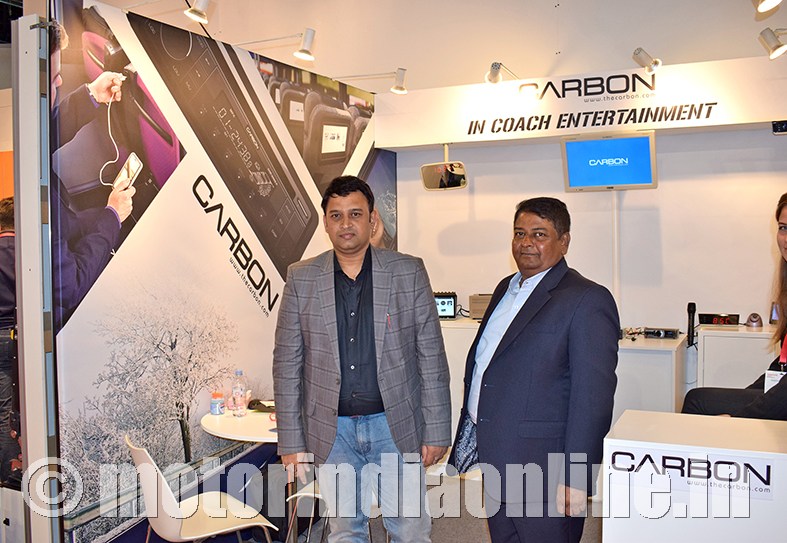
The company is working on servers for potential clients in India and soon going to install the same. They are providing USB charging solutions as well for the intercity buses. Apart from the servers that provide multiple infotainment, the company also offers digital clocks, speakers, DC/DC convertors, etc., as per the bus operators requirement.
Eberspacher’s new roof mounted unit
Making its presence felt was the new entrant from Eberspacher Sutrak’s AC 250 roof-mounted system with integrated heat pump. The company has applied to patent the design of the AC 250 which is a modular platform working with conventional refrigerants but capable of using CO2 in the future. The all-electric unit is designed for maximum efficiency in hybrid, electric and trolley buses. This operates according to a classic refrigerant circuit but allows for the air flow to be reversed when heating is required. Redirecting the airflow significantly simplifies the connections for the heat pump and enables a seamless transition from cooling to heating. Additional heat exchangers can be installed for the battery tempering system and the recovery of residual heat from other sources.
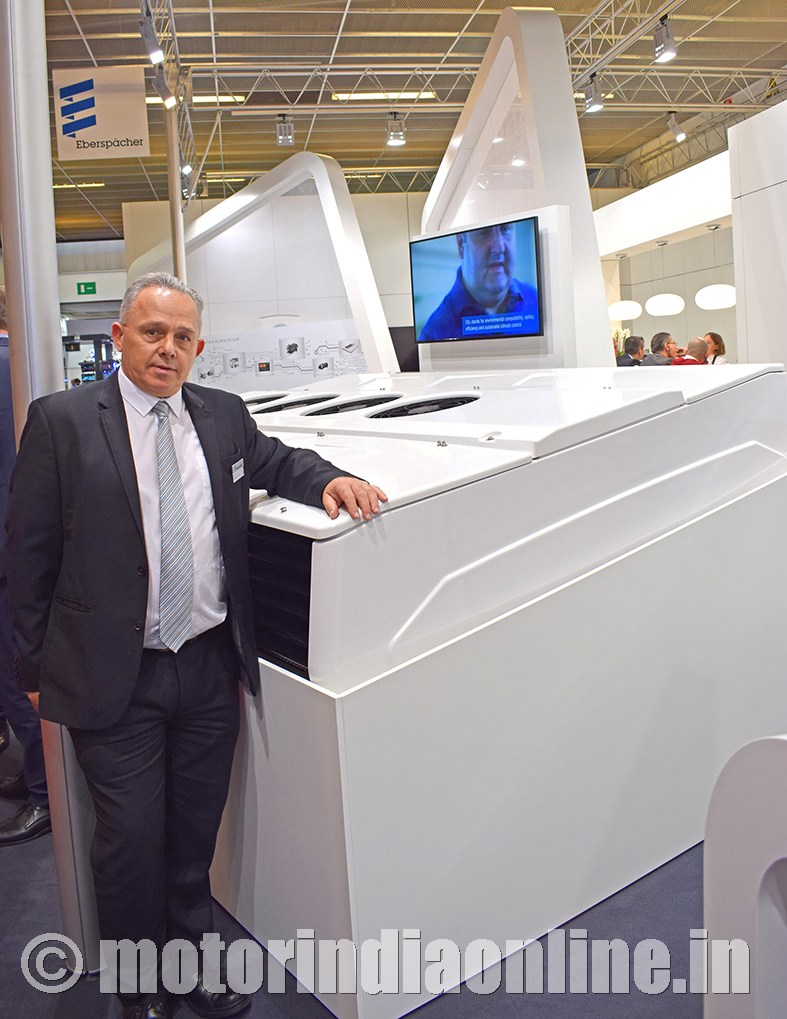
“The idea of the air cycle heat pump is that we have much simpler heat pump than a conventional reverse refrigerant cycle heat pump. The advantage of our unit is that we are also able to manage waste heat recovery on the vehicle. For example, if it is extracting waste air to bring fresh air in, there is heat in that air so we bring that heat out to make the air-conditioning system more refrigerant. This makes the system more efficient and the bus can run further on its batteries, which is known as the buzz word – range extensions,” informed David Rolls, Research & Development, Eberspacher. The company has solutions that can help reduce the power consumptions of the air-condition unit.
Hubner’s double pitch modular unit
Apart from a glass pillars and tree like structure booth layout, Hubner presented a modular construction system for multi-element vehicles. It also showcased the enhanced Exeo 500 lift system and a service-friendly electric ramp Exeo 500, a weight-optimized, heavy-duty lift with a lightweight construction that can handle loads up to 500 kg. Small dummy models were used to showcase the company’s products.
“We are showing a new concept for multi-unit buses. We have developed modular system to support bus builders who want to design multi-unit buses. An articulated bus has two units in the front and one in the rear. Another is a bi-articulated buses one axle in the rear of the front cart and one in the rear of the second cart and then if you have to add one more cart the bus movement will not be stable. Hence, we have a concept of two axle rear cart through which the bus can be lengthened up to 36 metres and for that you need new articulation where the double pitch articulation will be helpful. It can balance the two rear axle carts,” informed Dr. Stefanie Boge, Strategic Management Bus Division, Hubner GmbH & Co. KG.
Makersan CAN key-pads
Makersan showcase its wide range of key pads and and CAN based solutions in different forms and shapes. Variety included, Fingertip Joystick, Thumbwheel, Push Button, Navigation Pad. “The interesting thing about these one integrated keypad is that the bus builder can do away with 40-50 different switches and cables. It brings cost-saving, reduces maintenance and is easy to operate. Operators can customize the position of the button on the pad and use it to suit their comfort,” said Mr. Oktay Pehlivanoglu, Global Marketing Director, Makersan Makina Otomotiv.
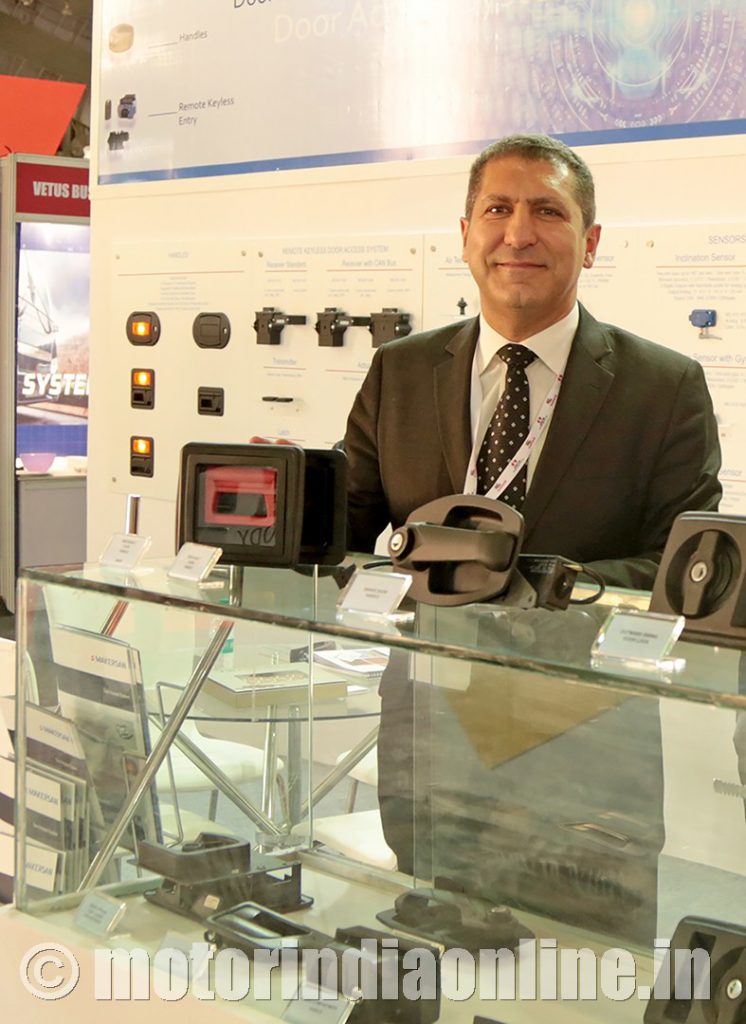
The company also showcased its core products like electronic accelerator pedal, brake pedals, keypads for door opening, capacitance touch sensors, acceleration sensors and hand throttles. It also had on display its remote keyless door access system devices like, receivers (standard and CAN Bus) Transmitor Actutator, latch and door handles. The last one door handles were customized with LED lights and without LED lights as well.
Voith’s cost-efficient range of offerings
Amongst its variety of products were Voith’s DIWA.6 transmission. Its unique long first DIWA gear allows for smooth, gear change-free moving off across a speed range in which other transmissions change gears two or three times. This means less wear on the entire driveline, which improves operating costs (TCO).
The DIWA.6 transmission offers additional savings potential through its stop-start function, which enables the engine to shut down when the vehicle is stopped for up to 180 seconds. Depending on how the bus is used, this represents fuel savings of 10-12 per cent. This not only reduces CO2 and NOx emissions, but also helps protect the environment and limits noise pollution.
Voith also showcased secondary water retarder (SWR), the first secondary retarder in the world that uses water to brake completely maintenance-free and with the potential to be disconnected from the driveline. The SWR is designed as a secondary retarder for buses and trucks. It uses engine coolant as its operating medium. With this, it carries out up to 90 per cent of all vehicle braking operations wear-free. Further, the secondary water retarder requires 50 per cent less installation space than its predecessor, is 35 kg lighter, and achieves a reduction in brake dust emissions of up to 80 per cent. For bus operators in particular, this is a critical factor when it comes to optimizing the efficiency of their vehicles.
Showcasing innovative skills of the company was the LP 560 air compressor with ‘twinsave’ technology. An additional control valve in the second compressor stage enables additional energy savings when idling as well as closed pressure line with an external control. Therefore, the technology uses both stages to save energy. This allows for savings of up to 25 per cent when compared to the industry reference scale.
Kiel’s heating seats & more
Kiel, a German company based in Nordlingen presented its complete range of seating solutions for a wide range of bus applications. Notable amongst them were the new Avance X in the ‘Basic’ and ‘Comfort’ levels. The Avance X boasts an ultra-modern design and many extras, high ergonomics and passenger safety as well as low weight and, thanks to its special technical concept, easily meets individual customer requirements.
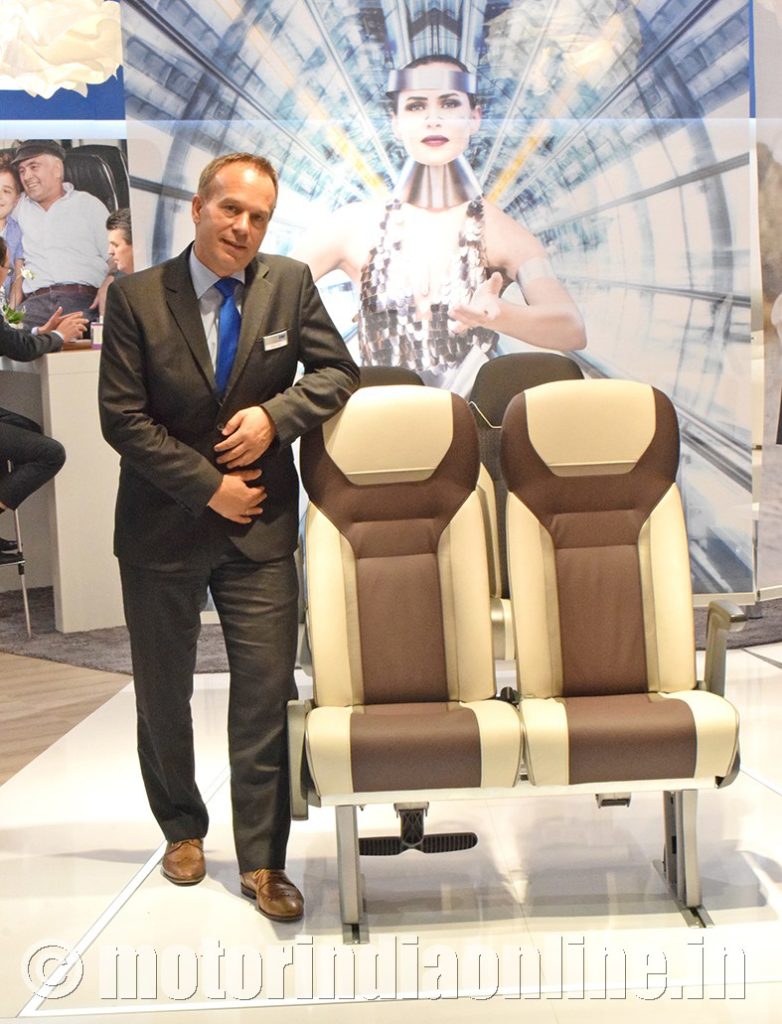
In addition, Kiel offered its Taxus, Citos and Avance (E) on display. Taxus had wooden seat pan, which, according to Heiko Krahn, Sales Director – Bus Division, Kiel, is one third in weight than plastic seat pans. The Citos-moulded bus seats too were lighter and weighed only 3.9 kg with fabric trim and foam.
Kiel also has customized arrangement for seats to ensure if the passenger seated is wearing a seat belt. The driver gets to see a red on the passenger who has not buckled. There are also seats with led lights that blinks when the passenger doesn’t belt. There are solutions offered using internet of things that can make the seat warmer as the passenger sits, during winters instead of using battery power to heat the entire coach.
BRIST focus on axles & suspension systems
With its VOITH TURBO origin, BRIST Axle Systems S.R.L. is considered one of the leading axle manufacturers of Europe for front and rear axle & suspension systems. BRIST provides complete solutions as a Full System Supplier (FSS) in various configurations for buses, coaches and light and medium trucks. Thanks to its broad field expertise, BRIST provides tailor-made solutions for the bus manufacturers without considering their size of operation. They were amongst the companies to showcase maximum new range of products, including rigid front suspension, independent front suspension, independent drive suspension and rear drive axles.
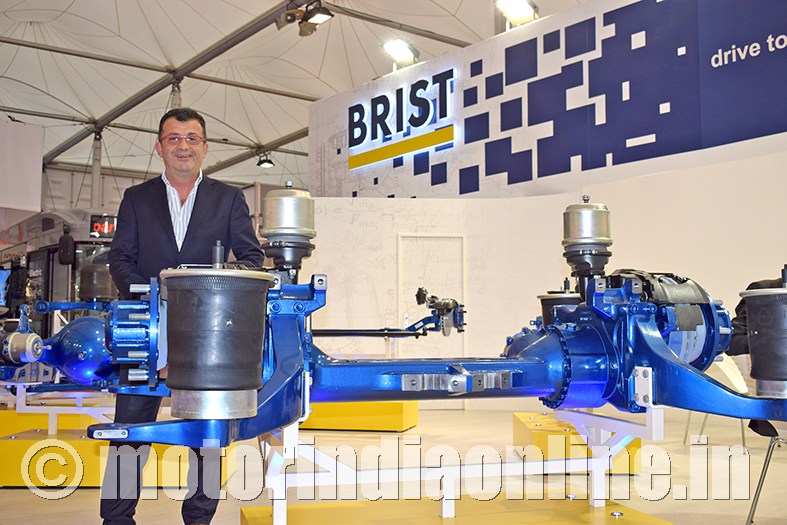
“This year we have added the rear drive axles with unique configuration for our customers. We participate for program of customers in the electric drive space. For e.g., BMC’s (Turkish bus manufacturer) first airport bus’ independent suspension was developed and supplied by us. Others are doing it with rigid axles for the same application, which is heavy and also takes a lot of space,” said Remzi Oduncu, Sales & Marketing Director, Brist Axle. In India too, the company is not considering the rigid axles.
Speaking about the new range, Mr. Oduncu added: “All independent axle range has been refreshed with pneumatics, made compact and light in weight. We are the only company in the world to provide independent axles in 3 variants, 17.5, 19.5 and 22.5 rims sizes. We recently introduced the inverted portal axle on 19.5 size which has been developed for buses. In our independent suspension range, we are showcasing the steering angle which is maximum in the market. We get air-springs from our Turkish partner. Last year we produced around 7,500 axles and are expecting serious growth in the next 3 years, almost triple the size of our current level.”
B-Style’s mobility solutions for differently-abled
As per the Indian Census 2011, the differently-abled population in India is 26.8 million. In percentage terms, this stands at 2.21%. There has been a marginal increase in the differently-abled population in India, with the figure rising from 21.9 million in 2001 to 26.8 million in 10 years. It only means our OEMs, particularly bus manufacturers, have to think about this ever-neglected group soon.
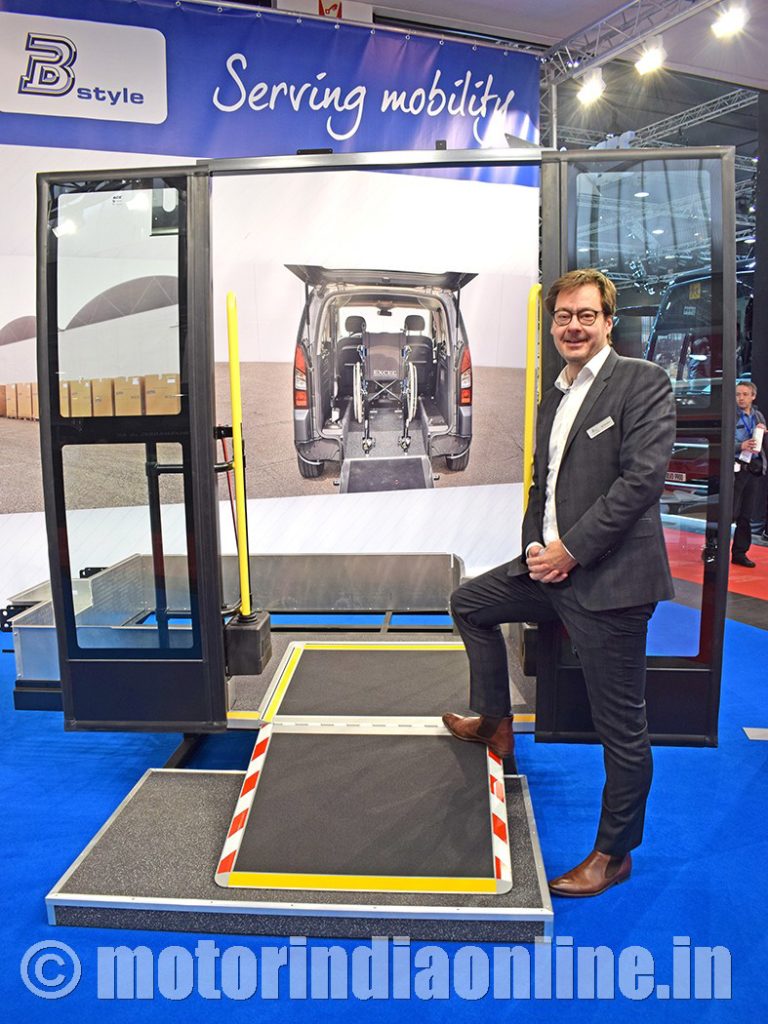
Pleasing the eye in this regard was B-Style, a Dutch company, offers mobility solutions to assist handicapped and elderly with modification like ramp to the vehicle. “We supply these modifications in the form of building kits to professional conversion companies. We deliver packages for conversions to neighborhood and minibuses, line and wheelchair taxis, buses for public transport, VIP and special transport. Together, with our partner we adapt, integrate and configure more than 2,500 vehicles a year. It is divided between rear low-floor for cars like the vans or it is a low entry middle low floor, everything from 4 to 34 passengers. We achieve this through a personal approach, an innovative development department and experienced professionals. All developments are done in accordance with the European regulations and the guidelines of the various vehicle manufacturers. The vehicles converted by our partners have therefore always been tested and approved according to the latest requirements,” informed Bart Smulder, Managing Director, B-Style.
At the Busworld the company showcased a wheel chair ramp, with the flexi light seat and the conversion kit on the Volkswagen Caddy Maxi. This conversion kit had a completely low with 85 cm width.
